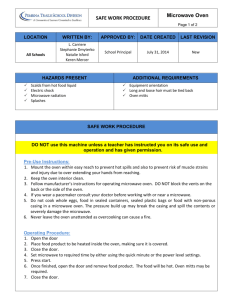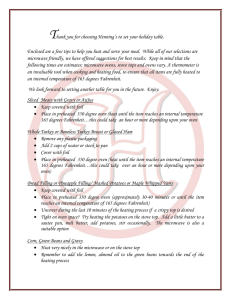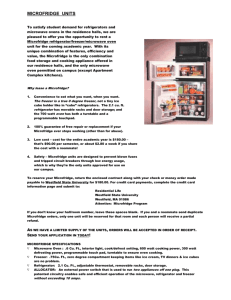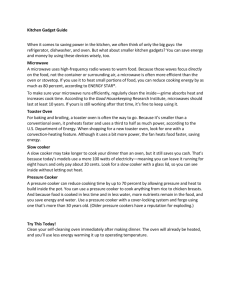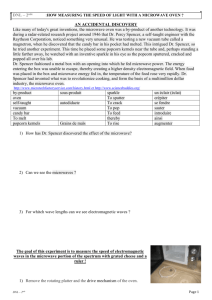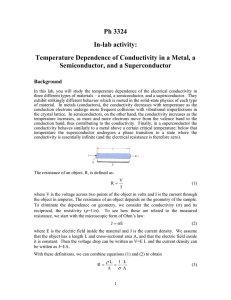Thermodynamics Homework
advertisement
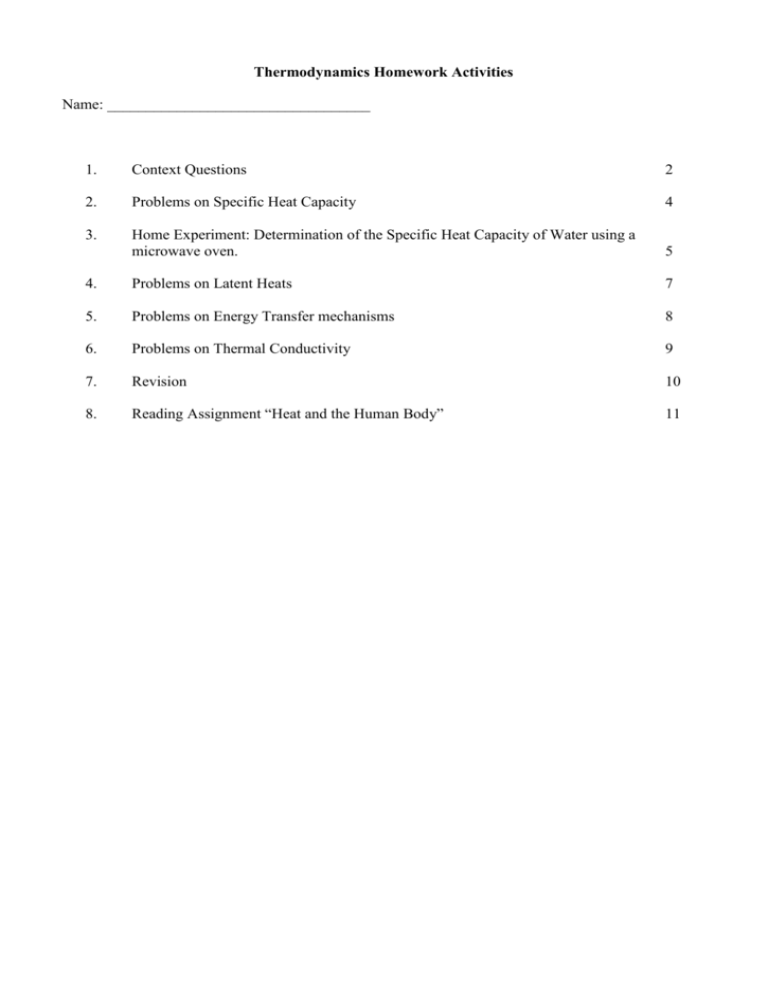
Thermodynamics Homework Activities Name: __________________________________ 1. Context Questions 2 2. Problems on Specific Heat Capacity 4 3. Home Experiment: Determination of the Specific Heat Capacity of Water using a microwave oven. 5 4. Problems on Latent Heats 7 5. Problems on Energy Transfer mechanisms 8 6. Problems on Thermal Conductivity 9 7. Revision 10 8. Reading Assignment “Heat and the Human Body” 11 Thermodynamics Questions The following questions have been generated by former students after doing the introductory activities. 1. How can people walk in red-hot coals without burning their feet? 2. Why can you bite into a pie that seems cool enough to eat and be burnt by the filling? 3. Why is it better to place a hot-water bottle in the bed rather than a hot brick? 4. What is the Fremantle doctor and what causes it? 5. What causes the radiometer to turn when exposed to light? 6. Why does the radiation not get stopped by the glass of the radiometer? 7. How does a thermistor work? 8. What is the wind chill factor and what causes it? 9. Why does metal expand when heated? 10. Why do black materials absorb heat? 11. Why does evaporation cause cooling? 12. When a liquid evaporates why does it take heat energy with it? 13. Why is it that water holds its temperature better than most substances? 14. How does the temperature difference produce electricity to run the fan? 15. Why does a thermometer have a lower reading after it is dipped in water and put in front of a fan? 16. Why does brass expand quicker than steel? 17. Why are steam burns more serious than boiling water burns? 18. How do fire doors reduce heat? 19. What is the difference in the make-up of different metals which allows some to conduct heat better than others? 20. How can you bake ice-cream in an oven at 2300C for three minutes without it melting? 21. Why do your bare feet feel colder on a tiled floor than on carpet at the same temperature? 22. Why is it important to cover up with heavy clothing in a bushfire? 23. Why does it get unbearably hot in a car on sunny days even if the air temperature is moderate? 24. Why is damp clothing sometimes more hazardous than no clothing at all? 25. Which has the greater cooling effect - an ice-cold drink or a hot cup of tea? Explain 26. Why are the climatic extremes in the southern hemisphere less than in the northern hemisphere? 27. Why do coastal cities have smaller temperature variations than inland cities at the similar latitudes? 28. What happens to heat energy in a vacuum? 29. What is water better at absorbing heat than ice? Your task 1. Read all the questions and use the physics ideas of this topic to group together questions that involve the same idea or two. For each group write down the number of the questions in the group and the physics ideas common to them. 2. Select six (6) questions from across the different groups and provide detailed answers of about 3 5 lines for each question. You may include a diagram if you wish. 2 Answer Sheet for Context Questions Task 1 Group A Questions: _______________________________________________________________ Common ideas: ___________________________________________________________ Group B Questions: _______________________________________________________________ Common ideas: ___________________________________________________________ Group C Questions: _______________________________________________________________ Common ideas: ___________________________________________________________ Group D Questions: _______________________________________________________________ Common ideas: ___________________________________________________________ Task 2 ______________________________________________________________________________ ______________________________________________________________________________ ______________________________________________________________________________ ______________________________________________________________________________ ______________________________________________________________________________ ______________________________________________________________________________ ______________________________________________________________________________ ______________________________________________________________________________ ______________________________________________________________________________ ______________________________________________________________________________ ______________________________________________________________________________ ______________________________________________________________________________ ______________________________________________________________________________ ______________________________________________________________________________ ______________________________________________________________________________ ______________________________________________________________________________ ______________________________________________________________________________ ______________________________________________________________________________ ______________________________________________________________________________ ______________________________________________________________________________ ______________________________________________________________________________ ______________________________________________________________________________ 3 Problems on Specific Heat Capacity 1. 2. 3. 4. How much energy is needed to warm 5.0 kg of blood in a child’s body from 340C to 370C? (Assume that blood has the same specific hear capacity as water). How many joules of energy are lost when 865g of aluminium cools from 1200C to 550C? (specific heat capacity = 8.80 x 102 J/kg/K). If 0.20 kg of water at 900C is mixed with 0.50 kg of water at 160C, what is the final temperature of the mixture? If 100 g of water at 950C is poured into a 500g glass cup, what is the final temperature of the water and the cup? (specific heat capacity of glass = 8.42 x 102 J/kg/K) ______________________________________________________________________________ ______________________________________________________________________________ ______________________________________________________________________________ ______________________________________________________________________________ ______________________________________________________________________________ ______________________________________________________________________________ ______________________________________________________________________________ ______________________________________________________________________________ ______________________________________________________________________________ ______________________________________________________________________________ ______________________________________________________________________________ ______________________________________________________________________________ ______________________________________________________________________________ ______________________________________________________________________________ ______________________________________________________________________________ ______________________________________________________________________________ ______________________________________________________________________________ ______________________________________________________________________________ ______________________________________________________________________________ ______________________________________________________________________________ ______________________________________________________________________________ ______________________________________________________________________________ ______________________________________________________________________________ ______________________________________________________________________________ ______________________________________________________________________________ ______________________________________________________________________________ ______________________________________________________________________________ 4 Finding the Specific Heat Capacity of Water Using a Microwave Oven Introduction The Microwave Oven can be used as a controllable energy source to raise the temperature of water. The oven can be operated at a known power setting and the time it takes for a measured mass of water to boil can be recorded. The Principle of the Conservation of Energy can then be used to calculate the Specific Heat of water, i.e. the energy supplied by the microwave equals the energy absorbed by the water. Microwaves are efficient in transferring energy, particularly into materials containing water, e.g. food. Microwave ovens usually have different power settings for High, Medium and Low. These often have the wattage specified on the front panel, if not, it is on the specification plate on the back. Aim: To determine the Specific Heat Capacity of Water Theory: By the Conservation of Energy, the energy supplied by the Microwave oven raises the temperature of the water. Energy supplied by the oven = Electrical Power x Time = Energy supplied to the water. Mass of water x Specific Heat Capacity of water x Temp. rise Note: The density of water is 1.00 gm/ml. Method: 1. Obtain 100 ml of water from the tap. 2. Measure the temperature of the water using a thermometer. (if only a medical thermometer is available, use some warm water to get the temperature of the water into its range. If there is no thermometer at all, mix some ice and about 150 ml of water together. Wait for several minutes while the melting ice brings the water down to 00C. Then pour 100 ml of water (only) into a wide glass bowl as in 3. below. If you have no access to ice carefully mix together hot and cold water until it feels the same temp as body temperature and assume the temp is 370C.) 3. Place the water in a wide glass bowl. 4. Set the oven onto High. 5. Turn on the oven and time how long it takes for the water to show strong evidence of boiling. 6. Repeat steps 1 – 5 twice 5 Results First Trial Second Trail Third Trial Volume of water ................... .................. ................... 100 ml Mass of water (kg) ................... .................. ................... 0.100 Kg Initial Water Temp (oC) ................... .................. ................... Measure Final Water Temp (oC) ................... .................. ................... 1000C Power setting (Watt) ................... .................. ................... Record Time (sec) ................... .................. ................... Measure Energy Supplied (Joules) ................... .................. ................... Calculate Heat Capacity (J/kg/oC) ................... .................. ................... Calculate Questions What assumptions have been made in this experiment? ................................................................................................................................................... ................................................................................................................................................... What are the sources of error? ................................................................................................................................................... ................................................................................................................................................... Do you think your value for the Heat Capacity will be an over-estimate or an under-estimate? Explain. ................................................................................................................................................... ................................................................................................................................................... What is your value for the Specific Heat Capacity of Water? ................................................................................................................................................... ................................................................................................................................................... 6 Problems on Latent Heats 1. 2. 3. 4. How much energy is required to melt 5.5 kg of ice at 00C? How much energy is released when 350 g of steam at 1000C condenses to water at 1000C? 100 g of ice at 00C is added to an insulated chamber containing 5 g of steam at 1000C. What is the final temperature of the 105 g of water? An electric kettle is rated at 1000 W. How long will it take to evaporate 100 g of water which is initially at 1000C? ______________________________________________________________________________ ______________________________________________________________________________ ______________________________________________________________________________ ______________________________________________________________________________ ______________________________________________________________________________ ______________________________________________________________________________ ______________________________________________________________________________ ______________________________________________________________________________ ______________________________________________________________________________ ______________________________________________________________________________ ______________________________________________________________________________ ______________________________________________________________________________ ______________________________________________________________________________ ______________________________________________________________________________ ______________________________________________________________________________ ______________________________________________________________________________ ______________________________________________________________________________ ______________________________________________________________________________ ______________________________________________________________________________ ______________________________________________________________________________ ______________________________________________________________________________ ______________________________________________________________________________ ______________________________________________________________________________ ______________________________________________________________________________ ______________________________________________________________________________ ______________________________________________________________________________ ______________________________________________________________________________ ______________________________________________________________________________ 7 Problems on Energy Transfer Processes 1. 2. 3. 4. 5. Which requires more energy, making soup or making toast? Explain What are the advantages of double glazed windows? When poor people are forced to sleep outdoors in cold weather they sometimes use newspapers for blankets. What good is this? Why? Why are loose-fitting clothes more comfortable than tight-fitting clothes in hot climates? How does a thermos flask keep food hot? ______________________________________________________________________________ ______________________________________________________________________________ ______________________________________________________________________________ ______________________________________________________________________________ ______________________________________________________________________________ ______________________________________________________________________________ ______________________________________________________________________________ ______________________________________________________________________________ ______________________________________________________________________________ ______________________________________________________________________________ ______________________________________________________________________________ ______________________________________________________________________________ ______________________________________________________________________________ ______________________________________________________________________________ ______________________________________________________________________________ ______________________________________________________________________________ ______________________________________________________________________________ ______________________________________________________________________________ ______________________________________________________________________________ ______________________________________________________________________________ ______________________________________________________________________________ ______________________________________________________________________________ ______________________________________________________________________________ ______________________________________________________________________________ ______________________________________________________________________________ ______________________________________________________________________________ ______________________________________________________________________________ ______________________________________________________________________________ 8 Problems on Thermal Conductivity 1. 2. A house without insulation in the roof loses a lot of energy. The heater maintains a temperature of 200C inside, while outside it is 120C. The ceiling has a k value of 0.13 W/m/K and is 4.0 cm thick. a) Calculate the energy loss if the roof area is 150 m2. b) Calculate the energy loss if the house is insulated with a 8.0 cm thick layer of fibreglass batts with a k value of 0.040 W/m/K) The bottom of a stainless steel frypan has an area of 0.10 m2. It is 8.0mm thick. The gas flame beneath the frypan is 2500C hotter than the inside of the frypan. a) How much energy is transferred to the interior every second if the conductivity of steel is 79 W/m/K? b) How much energy would be transferred every second if the bottom was made of copper? (k = 400 W/m/K) ______________________________________________________________________________ ______________________________________________________________________________ ______________________________________________________________________________ ______________________________________________________________________________ ______________________________________________________________________________ ______________________________________________________________________________ ______________________________________________________________________________ ______________________________________________________________________________ ______________________________________________________________________________ ______________________________________________________________________________ ______________________________________________________________________________ ______________________________________________________________________________ ______________________________________________________________________________ ______________________________________________________________________________ ______________________________________________________________________________ ______________________________________________________________________________ ______________________________________________________________________________ ______________________________________________________________________________ ______________________________________________________________________________ ______________________________________________________________________________ ______________________________________________________________________________ ______________________________________________________________________________ ______________________________________________________________________________ ______________________________________________________________________________ 9 YEAR 11 THERMODYNAMICS SUMMARY You need to: Temperature, heat and internal energy know the meanings of the words: latent heat, specific heat capacity, temperature, internal energy, power. describe the kinetic particle model of matter. explain temperature, heating and internal energy in terms of kinetic particle model of matter. know the unit of energy and the prefixes kilo and mega. know the meaning of specific heat capacity. use the specific heat capacity to calculate the final temp of a hot and cold mixture. describe changes of state. explain the latent heats of fusion and evaporation. calculate the energy required to boil or melt a known quantity. describe the temp – energy graph for heating up a cold solid to a hot gas. solve problems involving specific heat capacity and latent heats. know the meaning of power and what it is measured in. be able to use powers of ten in calculations. explain common experiences such as “Why is the filling of a pie so hot?” “How can people firewalk?” Energy in Transit know the meanings of the following terms: conduction, convection, radiation, insulators explain conduction, convection and radiation in terms of the kinetic particle model of matter. explain the meaning of thermal conductivity. calculate the rate of energy loss through a area such as a window using the thermal conductivity of glass. describe Newton’s Law of Cooling describe methods of reducing energy loss by conduction, convection and radiation. Keeping Comfortable know the meanings of the following terms: metabolic rate, evaporation. describe methods of energy loss from the human body. Describe the body’s temperature control mechanisms of shivering and perspiration. Reading Assignment From Jacaranda Physics 1st Edition Some interesting questions: 1. What is the rate of energy production of a human body at rest? 2. How much energy do you use up on the dance floor? 3. How much energy is lost per second by conduction through the body wall, ignoring blood flow? 4. How much energy loss occurs due to evaporation? 5. Why is conduction not a significant means of energy loss from the body? 6. What is the most effective energy transfer mechanism under neutral conditions? 10


